
Consider the most ancient mathematical object - the well-known, monotonically increasing 1D-series of the common finite Natural Numbers:
1, 2, 3, 4, 5, 6, 7, . . . (I)
Rewrite the quite "boring" 1D-sequence (I) in the following 2D-form:

It is evident that the number of strings in such
the 2D-form of the series (I) is infinte.
Consider, further, any property of Natural Numbers,
say, a predicate P(n) given on the 1D-set (I) or, that is now the
same, on the 2D-table. For example, consider the quite "trivial" set of
natural squares:
1, 4, 9, 16, 25, . . . (II)
and the predicat "to be or not to be a square of a natural number" or, more precisely:
It is natural that the colors are choiced arbitrary by our aesthetic liking.
So, we obtain the following color-musical 2D-image (so-called PYTHOGRAM after Great Pythagoras) of a quite abstract mathematical property "to be or not to be a square of a natural number" (unfortunately, we are forced to leave hear a beautiful, mathematical pythograms' Music off screen ):
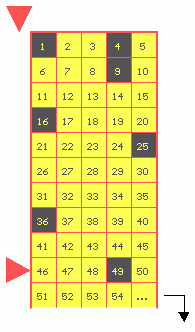
1. Quantity of numbers-cells in every string
of that 2D-table is called the MODULUS
(further - mod) of the pythogram.
2. The pythogram, as a whole, visualizes
the twice abstract CONNECTION
between the additivity and multiplicativity properties of
Natural Numbers: BTW, the ADDITIVITY
of Natural Numbers is modelled by its COLOUR,
the MULTIPLICATIVITY of Natural
Numbers is modelled by their POSITION
in the pythogram, since all numbers n, for which n = k
x mod
+ j, j < mod, holds, are placed in the same
j-th column of the pythogram.
3. According to the quite cogent argument
of known number theorists (Delone, Khinchin, etc.), main features of Number
Theory problems are defined just that twice abstract CONNECTION
between the additivity and multiplicativity properties of
Natural Numbers. Therefore, as a rule (but not always), we shall be interested
in not concrete properties of individual Natural Numbers, but just color-musical
pythograms of that twice abstract CONNECTION as a whole
("ornamental patterns").
1. We shall change the physical SIZE of pythogram cells ad liberum (by our wish). For example, we can decrease that size as follows :
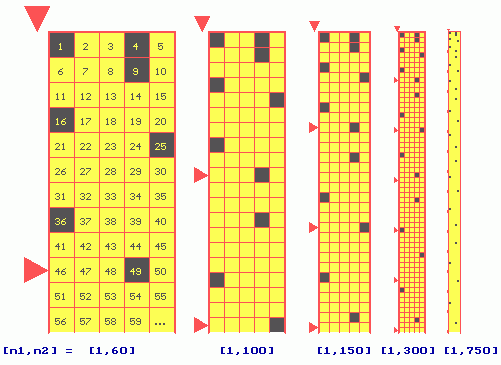
Such the trivial transformation allows essentially to increase the length of the segment of the series (I) that is visualized: here from [1,55] to [1,745].
Then, we can change a MODULUS of pythograms ad liberum (by our wish). For example, we can increase a modulus as follows :
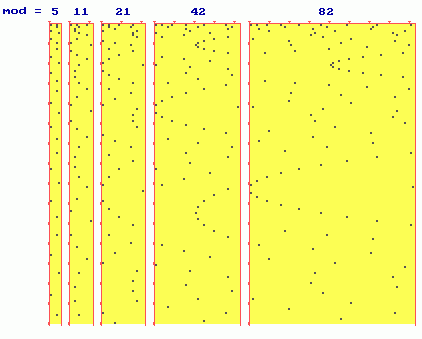
The modulus of pythograms is a unique degree of (mathematical) freedom, which essentially enlarges the segment length of the serties (I) under consideration (here from 745 to 12218). It allows to see absolutely new mathematical structures generated by common Natural Numbers which (such the structures) do not exist and can't be seen in the linear form of the 1D-series (I):
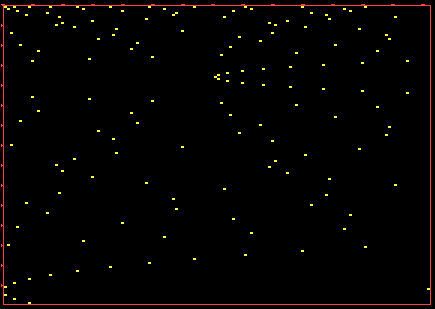
The 11 stills only! From the trivial Fig 1 to the very non-trivial Fig 5, - and we have seen what a whole Mathematics was not seeing ever from the Pythagoras' time! Let us try to understand what we are seeing now.
In a far "bevore-computer" epoch, great Gotfried Leibniz supposed that "figures are useful to awake a thought". The modern computer CCG-technology open unique opportunities just for awaking a non-traditional and non-standard mathematical thought. We suggest some not quite ordinary examples.
Let us try to understand the mathematical nature of some these visually-graphical structures. Successively changing the modulus of the phythogram, we create a color-musical movie, which at once prompts us the following unique VISUAL CCG-fact:
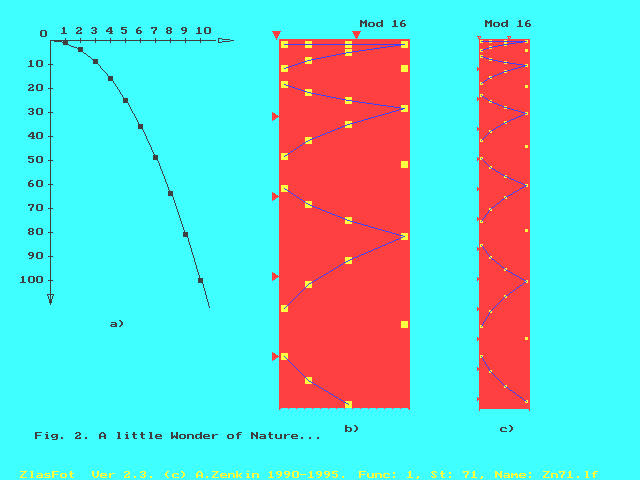
Fig. 6. The most beautiful and unexpected
CCG-Discovery: traditional (a) and non-traditional (b,c) forms of the visual
CCG-representation of the same mathematical object - of the well-known
natural squares set, {1, 4, 9, 16, 25, 36, ...}. We have got a certain
new “paradox” in modern mathematics: the distance between a) and b) figures
is equal to ... about 2000 years! Indeed, even Pythagoras
himself could draw b). Moreover, in 1841, Meobius
drew very similar parabolas, - even just by the modulus 16 (!), - as a
nomogram for multiplication of natural numbers in his known nomographical
works. But only CCG-technique has allowed us to see, in the first time,
this fantastic transformation! Indeed, the well-known ONE,
but INFINITE, parabola is transformed
into the INFINITE FAMILY
but of FINITE parabolas! Such the transformation
is not known in the modern Mathematics, and it brings to light new aspects
of the eternal philosophical problem about a connection between the Finiteness
and the Infiniteness.
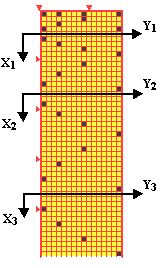
A quite not usual equation of a parabola in any n-th local coordinate system is as follows:

The equation of the infinite family of the finite parabolas in the coordinate of the CCG-space (Fig. 8) is as follows:
EXAMPLE. Let n=4,
l = k - 8.
|
|
|||||||||
|
|
|
|
|
|
|
|
|
|
|
|
|
|
|
|
|
|
|
|
|
|
|
|
|
|
|
|
|
|
|
|
|
|
|
|
|
|
|
|
|
|
|
|
So, here n is a parabola
number; but the "value" of the function Y*(n)
is not a usual number, but it is a sequence of the following NINE
squares of successive natural numbers:
(8n-4)2,
(8n-3)2, (8n-2)2,
(8n-1)2, (8n)2
, (8n+1)2, (8n+2)2,
(8n+3)2, (8n+4)2,
generating the n-th parabola for every n = 1, 2, 3, … .
Thus, a "point" (!) Y*(n) describes a whole GEOMETRIC object - the corresponding n-th parabola. In other word, that infinite family is simply the following sequence of finite 9-points parabolas:
Y*(0), Y*(1), Y*(2), . . . , Y*(n), . . . (III)
So, the sequence (III) is a sequence of NEW FINITE GEOMETRICAL OBJECTS that are VIRTUAL - in the common series (I), and are REAL - in the CCG-Space.
Let us look at the following pythogram of the predicate "to be or not to be a square" under a successive change of its modulus. For example, let the mod be equal to 8, 9, 10, . . . 20.
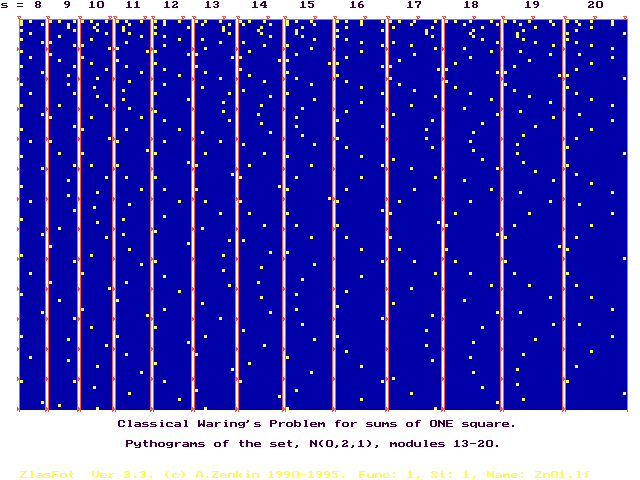
As it is easy to see (better, from right to left),
some parabolas are jumping, others
are moving down monotonically and dignifiedly.
Consider the last type of parabolas on the following
pythogram modulo mod=18:
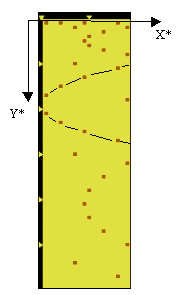
The equation of such the running parabola in the shown coordinate system is such:
So, the function, Y*(X*) = Y*(mod), discribes and visually represents a REAL GEOMETRICAL object, - the finite parabola, - in every point X* = mod = 3, 4, 5, . . .
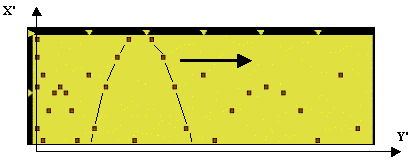
As is known, in Physics, an isolated, solitary wave
is called a SOLITON.
So, our isolated, solitary parabolic wave in Fig. 11, is a PARABOLIC
SOLITON, propagating along the integer axis Y' = 1, 2, 3, .
. .,
No mathematician, from the Pythagoras' time, ever
guessed that a lot of virtual geometrical objects of such the new type,
the parabolic solitons, are running along the usual series of the common
Natural Numbers during centures, and nobody saw them. Only CCG-approach
allowed really to reveal such the DYNAMIC GEOMETRICAL OBJECTS in the Cognitive
Reality of the CCG-Space.
On the jumping parabolas I shall tell you next time.
attracts attention of artists, sculptors, architects, and so on.
On the 23 October, 1999, the known Russian painter
Alexander Pankin, using CCG-Visualization approach,
drew (without any computer!) some pythograms of initial segments of the
Natural Numbers series (I) with the predicate:
P(n) = " n is a Fibonacci Number", (1)
and HAVE SEEN the following (see Fig. 12)
VISUAL FACT 1. The threes of
Fibonacii's Numbers (21,13,5), (34,21,8), and (55,34,13) make
up straight lines, and the threes of Fibonacii's Numbers (3,8,13),
(5,13,21), and (8,21,34) are placed in one column.
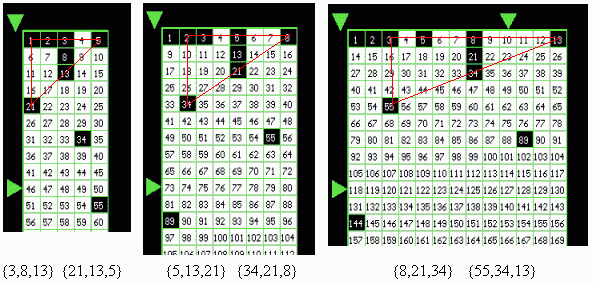
Fig. 12. Pythograms of initial segments of Natural Numbers Series (I) with the predicate (1). The modules of these pythograms are equal to the Fibonacci's Numbers 5, 8, and 13, correspondingly.
Then he came out with a HYPOTHSIS that such the property
holds for ALL pythograms of such the kind. Our CCG-System confirmed that
the Pankin's hypothesis is very plausible (see Fig. 13 and 14).
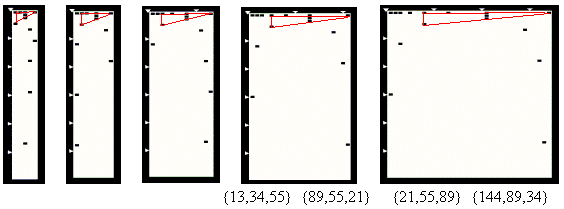

Consider ANY SEVEN of successive Fibonacci's Numbers {f1, f2, f3, f4, f5, f6, f7, } and the corresponding pythogram modulo f4 with the predicate (1). The pythogram modulo 13, presented in Fig. 15, illustrates the situation for the third seven {3,5,8,13,21,34,55}.

Introduce the following designations.
Local coordinate system connected with the triangle
ABC:
Origin: C(0,0); X-axis: the line CB; Y-axis: the
line CA.
In this local coordinate system, the points A - E will have the following coordinates, expressed via Fibonacci's Numbers:
PROOF.
a) THE EQUATION OF THE LINE AB. From
(Y - YA )/( YB - YA ) = (X - XA )/( XB - XA) and (Y - 4) / (-4) = X / (f4 - f1), we have
4 X + (f4 - f1) Y - 4 (f4 - f1) = 0 (2)
b) From the definition itself of the Fibonacci's Numbers we have:
(f3 = f4 - f2 ) & (f3 = f2 + f1) ® (2f3 = f4 + f1) ® (f3 = (f4 + f1)/2).
f3 - f1 = (f4 + f1)/2 - f1 = (f4 - f1)/2.
c) Since E(f3 - f1 , 2) = E((f4 - f1 )/2, 2), we have for the point E from (2) :
4 (f4 - f1 )/2 + (f4 - f1) 2 - 4 (f4 - f1) = 0.
So, the point E(f3 - f1 , 2) really lies on the side AB of the triangle ABC.
THEOREM 2. FIBONACCI NUMBERS f3 , f5 , f6 BELONG TO THE SAME COLUMN, f3 , OF THE PYTHOGRAM MODULO f4 , SO THAT THE NUMBERS f3 , f5 , f6 ARE A MIGLINE OF THE TRIANGLE ABC.
PROOF. By the definition itself
of the Fibonacci's Numbers, f5 = f4 + f3,
f6= f5 + f4 = 2 f4 + f3.
So, f3 , f5 , f6 = f3
(mod f4), i.e., the numbers f3 , f5 ,
f6 belong to the same column, f3 , of
the pythogram modulo f4 and are placed in the strings
1,2,3, correspondingly. Since (f3 - f1 =
f2 ) & (f4 - f3 = f2
) and the columns with numbers f1 and f3 are
always parallel, the line made up by the numbers f3 , f5
, f6 is a midline of the rectangular triangle ABC.
P(n) = " n is a Fibonacci Number", (1)
and HAVE SEEN the following (see Fig. 16)
VISUAL FACT 2. The pythograms
by modules 6, 10, 16, which are not Fibonacii's Numbers,
have topologically invariant structure like "metyl-cyclopropan".
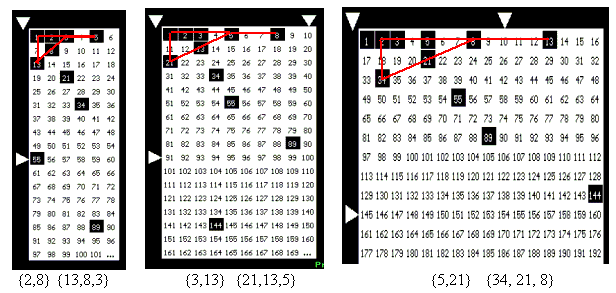
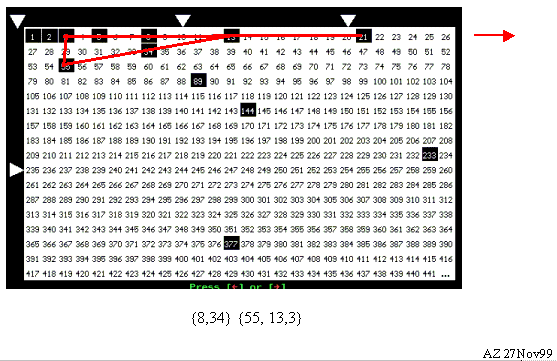
Since Mathematics takes on trust nothing, this visual hypothesis was proved next day.
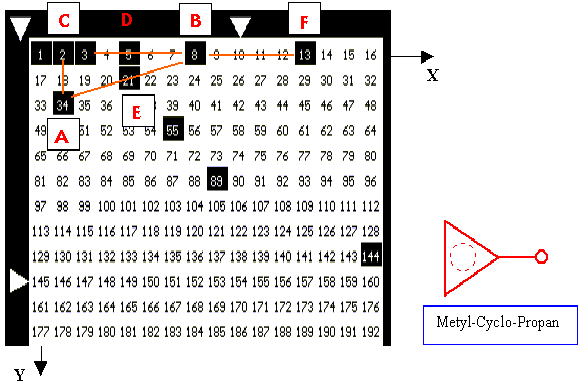
In this local coordinate system, the points A - F will have the following coordinates, expressed via Fibonacci's Numbers:
THEOREM 3. THE POINT E LIES ON THE SIDE AB OF THE TRIANGLE ABC.
PROOF. a) THE EQUATION OF THE LINE AB. From
(Y - YA )/( YB - YA ) = (X - XA )/( XB - XA) and (Y - 2) / (-2) = X / (f4 - f1), we have
2 X + (f4 - f1) Y - 2 (f4 - f1) = 0 (3)
b) From the definition itself of the Fibonacci's Numbers we have:
(f3 = f4 - f2 ) & (f3 = f2 + f1) ® (2f3 = f4 + f1) ® (f3 = (f4 + f1)/2).
f3 - f1 = (f4 + f1)/2 - f1 = (f4 - f1)/2.
c) Since E(f3 - f1 , 1) = E((f4 - f1 )/2, 1), we have for the point E from (3) :
2 (f4 - f1 )/2 + (f4 - f1) 1 - 2 (f4 - f1) = 0.
So, the point E(f3 - f1 , 1) really lies on the side AB of the triangle ABC.
THEOREM 4. FIBONACCI NUMBERS f3 and f6 BELONG TO THE SAME COLUMN, f3 , OF THE PYTHOGRAM MODULO 2f4 , SO THAT THE NUMBERS f3 and f6 ARE A MIGLINE OF THE TRIANGLE ABC.
PROOF. By the definition itself
of the Fibonacci's Numbers, f6= f5 + f4
= 2 f4 + f3. So, f3 , f6
= f3 (mod 2f4), i.e., the numbers f3
and f6 belong to the same column, f3
, of the pythogram modulo 2f4 and are placed in the strings
1 and 2, correspondingly.
Since (f3 - f1 =
f2 )& (f4 - f3 = f2
) and the columns with numbers f1 and f3 are
always parallel, the line made up by the numbers f3 and
f6 is a midline of the rectangular triangle ABC.
IMPORTANT REMARK.
The calssical series of Fibonacci's Numbers is generated by the initial pair {0,1}:
{0, 1} 1, 2, 3, 5, 8, 13, 21, 34, 55, 89, . . . (IV)
All the Theorems proved above use the DEFINITION ONLY of the Fibonacci Numbers. Thefore they hold for the GENERALIZED FIBONACCI SERIES produced by any initial pair of integers {m,n}.
Now, let us return to the habitual, most ancient mathematical object that is investigated during about 5000 years, - to the usual series of the usual finite Natural Numbers:
1, 2, 3, 4, 5, 6, 7, . . . , n, . . . (I)
But nobody, from Pythagoras' time, even guessed that
there exists a stormy life of virtual FINITE GEOMETRICAL OBJECTS in this
series (I). And only the CCG-technology of the cognitive-semantic visualization
of mathematical abstractions has allowed to see such the objects and to
understand some of their unexpected and wonderful mathematical properties.
It's wonderful that some of these CCG-discoveries
was made by non-professional mathematicians, but just a painter and a chemist
(see above). That allows to state that our CCG-Technology is really an
effective way to scientific discoveries.
We believe that great Leopold
Kronecker was right, a thousand times, saying
Our today's CCG-results, concerning the Virual Geometry
of Natural Numbers, can be presented in the next "2D-form".
|
|
|
|
|
|
|
|
|
|
|
|
|
|
|
|
|
|
|
|
|
|
|
|
|
1. A.A.Zenkin, Cognitive Computer Graphics. Applications in
Number Theory. - Moscow: "NAUKA", PhysMath. Literature, 1991,
191 pp.; 30 000 copies.
2. The WEB-Site http://www.com2com.ru/alexzen/
3. A. A.Zenkin, Cognitive (Semantic) Visualization of the Continuum
Problem and Mirror-Symmetric Proofs in the Transfinite Number Theory.
- International e-journal "VISUAL MATHEMATICS", Vol. 2, at the WEB-Sites:
http://www.mi.sanu.ac.yu/vismath/zen/index.html
http://members.tripod.com/vismath1/zen/index.html
4. A.A.Zenkin, Waring's problem from the standpoint of the
cognitive interactive computer graphics. - An International Journal
- "Mathematical and Computer Modelling", Vol.13, No. 11, pp. 9 -
25, 1990.
5. A.A.Zenkin, Some picturesque generalizations of Nechaev-Waring's
problem obtained by means of cognitive interactive computer graphics.
- An International Journal "Mathematical and Computer Modelling",
Vol.13, No. 11, pp. 27 - 36, 1990.
6 A.A.Zenkin, Generalized Waring's Problem: On One New Additive
Property of Natural Numbers. - “Matem. Zametki”,
Ňîě 58, No.3, 372 - 378, 1995 {Translated in: "Mathematical Notes",
vol. 58, no. 3, pp.933-937 (1995)}.
7. A.A.Zenkin, Superinduction: A New Method For Proving General
Mathematical Statements With A Computer. - Doklady Mathematics,
Vol.55, No.3, pp. 410-413 (1997). Translated from Doklady Alademii Nauk,
Vol 354, No. 5, 1997, pp. 587 - 589.
8. A.A.Zenkin, The Time-Sharing Principle and Analysis of One Class
of Quasi-Finite Reliable Reasonings (with G.Cantor's Theorem on the Uncountability
as an Example) - Doklady Mathematics, vol 56, No. 2, pp. 763-765
(1997). Translated from Doklady Akademii Nauk, Vol 356, No. 6, pp. 733
- 735.(1997).
############################################
Prof. Alexander A. Zenkin,
Doctor of Physical and Mathematical Sciences,
Leading Research Scientist of the Computing Center
of the Russian Academy of Sciences,
Member of the AI-Association and the Philosophical Society of the Russia,
Full-Member of the Creative Union of the Russia Painters.
e-mail: alexzen@com2com.ru
WEB-Site http://www.com2com.ru/alexzen
"Artistic "PI"-Number Gallery":
http://www.com2com.ru/alexzen/gallery/Gallery.html
############################################
"Infinitum Actu Non Datur" - Aristotle.
"Drawing is a very useful tool against the uncertainty
of words" - Leibniz.